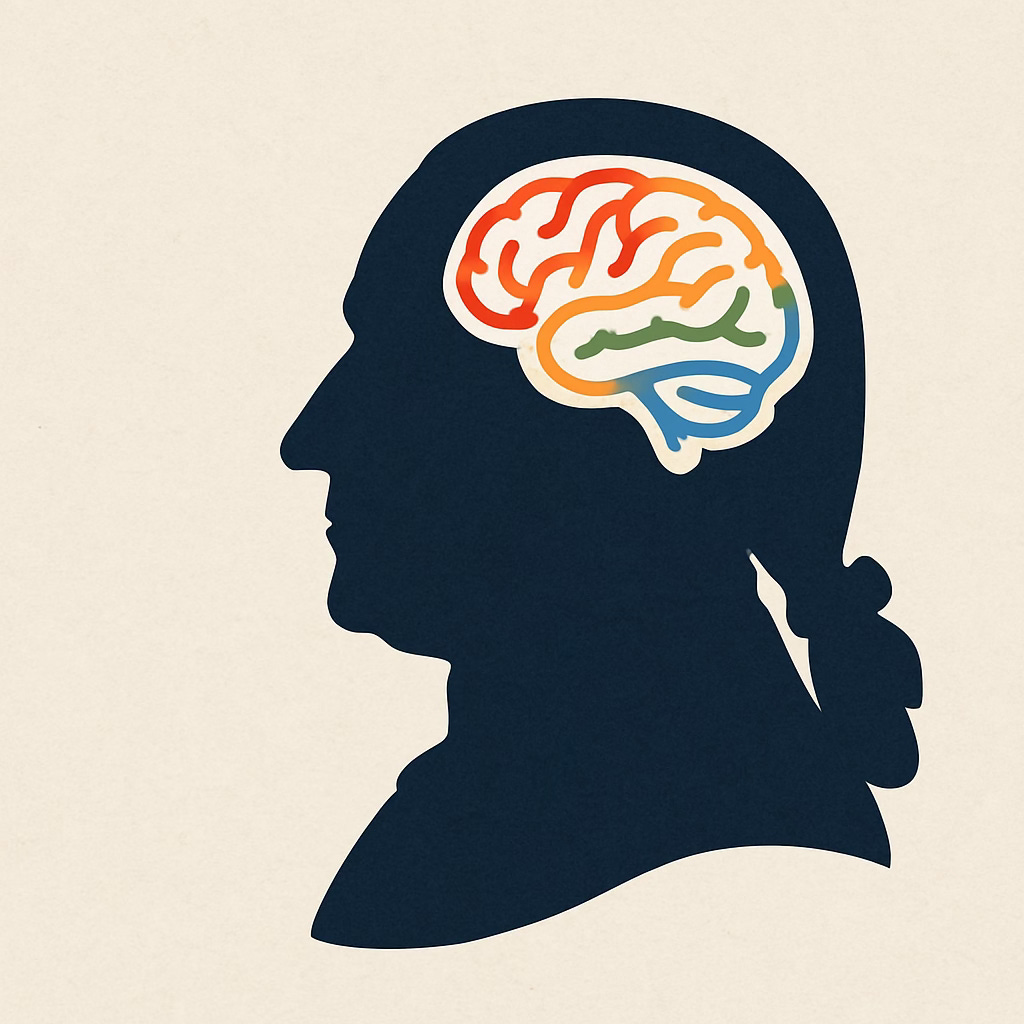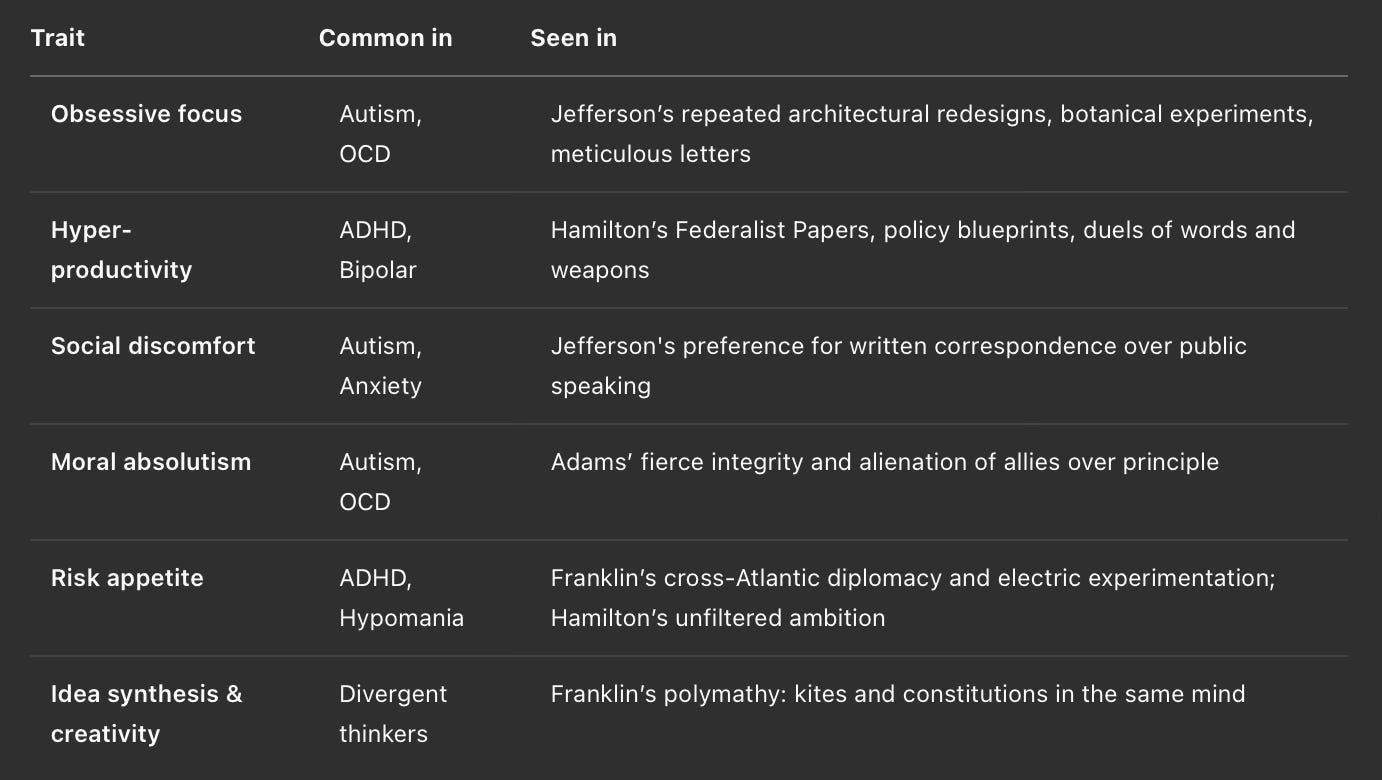The Enlightenment as a Neurodivergent Revolution
From the THX Series Hub: Neurodivergence & the Founding of a Nation
How the Founding Fathers’ Minds—and the Moment—Created a Nation Built on Cognitive Dissent
“We hold these truths to be self-evident…”
But who sees truth that way? And what kind of mind dares to put it in writing?
What We Mean by “Neurodivergence” (Without Diagnosing the Dead)
Let’s start with a respectful clarification.
We’re not here to diagnose Thomas Jefferson with autism, Hamilton with ADHD, or Franklin with hypomania. That’s speculative, and as many scholars remind us, retrospective diagnosis can reinforce myths or misunderstandings when we project modern mental health frameworks onto historical figures.
Instead, we’re asking something more transformational:
What kind of minds reimagine the world—not just accept it?
Neurodivergent Traits, Not Labels
Let’s briefly define a few cognitive traits commonly seen in neurodivergent individuals—then trace them through the lives of the Founders:
We’re not diagnosing—we’re noticing. Pattern recognition is, after all, one of the traits at play.
The Enlightenment as a Culture of Cognitive Asymmetry
Why then? Why there?
Because the Enlightenment was one of the rare historical epochs where:
Reading was valorized.
Correspondence networks made asynchronous conversation possible.
Rational argument and emotional urgency were both praised.
Experimentation, system-building, and curiosity weren’t just tolerated—they were funded.
In other words: society became, temporarily, optimized for neurodivergent cognition.
This was an era when you could:
Obsess over logic and still be called a patriot.
Be awkward in person, but eloquent on parchment.
See what others couldn’t—and still be trusted to lead.
The Pathway of Transformation: From Usefulness to Admiration
Transformation doesn’t begin with inspiration. It begins with utility. It starts when something is useful enough to be tolerated, then integrated, then respected.
Let’s walk the path:
The 12 Utilities: Designing Usefulness
The Founders built systems that delivered essential forms of utility:
Availability: Revolutionary ideals made widely accessible through pamphlets, speeches, and declarations.
Access: Participation through local assemblies, state conventions, and revolutionary networks.
Security: The Constitution and Bill of Rights structured protections against tyranny.
Clarity: The Declaration distilled grievances into shared truths.
Ease of Use: Governing principles translated into state charters and the Federalist Papers.
Accuracy: Legal and philosophical rigor formed checks and balances.
Speed: While not instantaneous, the revolutionary process accelerated civic innovation.
Consistency: Core values were echoed across founding documents.
Closure: Peaceful transitions of power, especially under Washington.
Emotion Evoked: Stirring appeals to liberty, justice, and shared purpose.
Resource: Enlightenment ideas as a wellspring of governance.
Value: The creation of a government "of the people, by the people, for the people."
These utilities created trust. Trust enabled participation. Participation made room for something deeper.
PERMAH: Engaging the Human Spirit
Once basic needs and cognitive structures were in place, Founding-era leadership tapped into deeper human drivers:
Positive Emotion: Hope, purpose, and relief from monarchy
Engagement: Intense debate, letter-writing, public discourse
Relationships: Bonds of trust, mentorship, and correspondence
Meaning: Fighting for a cause larger than the self
Achievement: Founding institutions, winning independence
Health: Physical resilience through war; spiritual vitality through ideas
When citizens pursue these for their own sake, they no longer follow—they belong. A community begins to form.
The Admiration Equation: When Utility and Identity Converge
Admiration is born when utility meets identity and aspiration. We admire those who:
Solve a problem we care about (utility)
Reflect who we are or who we wish to be (identity)
Model courage, wisdom, or creativity (aspiration)
The Founders became admired because they:
Designed a government that served real needs
Embodied courage and sacrifice
Gave voice to values that transcended self-interest
Even when flawed, they lived in alignment with a belief in the future.
The Emergence of Something New
What emerged was not just a new nation, but a new template for civic identity:
Leadership as thought and design, not just bloodline or battlefield charisma
Structure as a moral act
Emotional resonance as a political tool
Divergence not as weakness, but as fuel for possibility
The United States was not born of sameness. It was born of asymmetry, tension, and the strange beauty of unalike minds converging on shared purpose.
Reflection and Challenge
Who today is building the next system not from conformity, but from cognitive difference?
What small utility might become the seed of transformation?
Where are people already thriving on PERMAH, even if no one has noticed?
Who do you admire—not just for what they do, but for how differently they see?
Let’s stop designing systems that reward sameness. Let’s design for emergence.

Interpretation:
The juxtaposition of Enlightenment-era aesthetics with vibrant brain imagery signals that what we now call neurodivergence may have powered the cognitive, emotional, and structural revolutions of the founding era. It invites readers to see the Founders not only as political architects—but as cognitive outliers who leveraged their unique minds to reshape the world.




